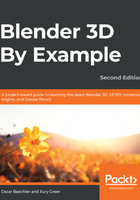
Adding the horns
Historically, Vikings didn't actually have horned helmets, but this is our world, so we can add whatever we want!
Remember how we mentioned that you would be using the Extrude tool over and over again? Well, guess what? We're going to extrude again here:
- Switch to face selection mode by pressing 3 on the home row of the keyboard.
- Rotate your view with the middle mouse button so that you can see the area of the helmet that the horn will be extruded from:

Just like when we extruded the nose guard, the first step is to make a selection. We have a lot of really fancy selection methods that we can use, but some of them aren't visible in the UI right now. You may have noticed that some of the tool icons on the Toolbar have a tiny arrow in the bottom-right corner.
This means that there are similar tools stacked underneath that tool. Let's try out the Select Circle tool, which is stacked underneath the Select Box tool:
- Click and hold down the left mouse button on the Select Box tool to expand the list of stacked tools, as shown here:

- While the mouse button is still held down, hover over the Select Circle tool.
- Let go of the mouse button to activate the Select Circle tool.
- Hover the little selection circle over one of the Viking Helmet's round white side pieces.
- Click and drag the circle to select all of the white polygons, as shown here:

There! Wasn't that easy? The next step is... you guessed it, extrude!
- Activate the Extrude Region tool again.
- Click and drag the yellow plus (+) symbol on the gizmo to extrude the first piece of the horn, as shown here:

We're off to a good start, but these horns should be curved. Unfortunately, the only way to make a 3D model curved is to add lots and lots of extra polygons, so we're going to have to extrude over and over again. The problem is that with each extrusion, we will have to make small adjustments to the position, rotation, and scale. That's going to involve a lot of back and forth between the extrude tool, the move tool, the rotate tool, and the scale tool, but there is a better way of doing this! We'll use one of the alternative extrude tools stacked underneath the Extrude Region tool:
- Make sure you still have the same polygons selected from the previous step.
- Press the Tilde ~ key to bring up the View pie menu.
- Choose the Front option from the pie menu in order to rotate the view to the front of the helmet, as shown here:

- Click and hold down the left mouse button on the Extrude Region tool to expand the list of stacked tools, as shown here:

- While the mouse button is still held down, hover over the Extrude to Cursor tool.
- Let go of the mouse button to activate the Extrude to Cursor tool.
- Hover your mouse over the position you would like to extrude the horn toward.
- Left-click to extrude the horn to the position of the mouse, as shown here:

Excellent – the Extrude to Cursor tool took care of the position and rotation at the same time as extruding! Now, all that's left is the scale. It would be nice to avoid switching back and forth between the Extrude to Cursor and Scale tools, so it's time to learn about a new hotkey. The hotkey for the scale operation is S. This hotkey automatically begins scaling as soon as you press it, no gizmo required:
- Hover the mouse near (but not directly on top of) the selected polygons.
- Press the S hotkey to begin scaling.
- Drag the mouse slightly closer toward the horn so that the extruded piece tapers slightly, as shown in the following screenshot.
- Left-click to confirm the scale operation:

Perfect! The great thing about using the s hotkey for scale is that our Extrude to Cursor tool remains active, so we can finish the horn without switching tools over and over:
- While the Extrude to Cursor tool is still active, left-click to extrude the next small section.
- Press the S hotkey to begin scaling down the newly extruded section.
- Drag the mouse inward to shrink the selected polygons.
- Left-click to confirm the scaling operation.
- Repeat these steps as many times as needed to finish making the horn.
Have fun with your design! Our example turned out like this:

When you're finished with your horn, we can symmetrize the helmet again:
- Go to the Mesh menu in the header of the 3D Viewport.
- Choose Symmetrize from the Mesh menu.
- Use the Adjust Last Operation panel to change the Direction of the Symmetrize operation if needed.
Beautiful! That's a fine pair of horns. Our example turned out like this:

Now that we have a nose guard and horns, all that's left is to make some pyramid studs for decoration.